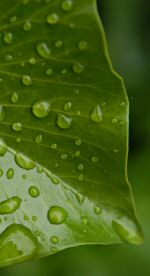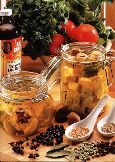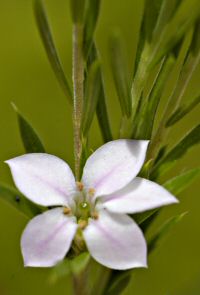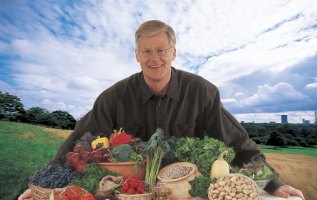|
|

 綠色植物是我們最重要的食物來源,因爲它們可以提供我們所有健康所需要的必需營養成分。它們既是我們的食物,又是我們的藥物。幾乎每一項健康的問題都可從攝入綠色食品而裨益。其中最好的是有機綠色食品,因爲它們富含有必需的營養素。
「人們不能在無法長出綠色植物的地方生活」
請下載伍德精選綠中寶的PDF文件(457K—僅限於英文) (如欲閲讀PDF文件,須使用Adobe公司的免費Acrobat™ Reader)
我們這裡所指的「綠色生物」是包括生長在鹹水及淡水中不同種類的植物(藻類)、陸地上的植物、由陸生狀態又回到水生環境的植物,這些食物的共通性是它們都是綠色的。「綠色生物」是人類健康及再生的最基本的要件。自古以來,它們就是提供生物成長取之不盡的食物來源。

生物學家認爲,陸地上的植物是從單細胞的水生生物進化而來,它們大約在五億年前才開始出現在陸地。植物以及它們的綠色祖先都富含有鎂的葉綠素。葉綠素是在植物的葉綠體中綠色的色素。葉綠素的功能是使植物體吸收太陽光能並進行光合作用,這使得地球成為一個綠色的星球。
「綠色生物」佔據地球的幾乎所有地區。它們可以出現在花園、森林中、田野、草地上、山上、谷地、海洋中、窗臺上(從種子裡冒出來)、室內的花盆中。它們包括草、葉、藥草、藻類、海草、濶葉植物、樹、苔蘚、地衣、蕨類、灌木、雜草以及許多其他植物。

在希臘語裏,"phyto"意思就是植物。因此phytochemicals一詞按照定義所指的就是來自植物所具有生物活性的化合物。它們在植物體內所發揮的是免疫系統的功能,使植物能夠抵抗所受到的疾病和病毒的侵害。植物化學品决定植物的顔色、口味,並幫助植物有機體為存活而必須完成的許多生物方面的任務。
植物中有數千種植物化合物。人類直到最近才開始對這種十分有價值的食物化合物的分子結構進行研究。這類物質的具體實例有:類胡蘿蔔素、類黃酮、植物甾醇、多酚類、木脂素、硫化物、薑黃素、皂角苷、香豆素、萜烯醇、鄰苯二甲酸以及其他的許多物質。隨著研究的不斷進展,我們對這些物質的本質及其如何幫助人們保持健康,將會有新的瞭解
植物營養素指的是可作爲食物的植物性化學物品。植物性藥物可以誘發哺乳動物身體系統的生物反應,這些反映總是能降低一或數種慢性疾病的風險。自有人類以來就已經善用富含植物性化學物的綠葉和植物的其他部分,從攝取這些物質來改善健康。
綠色植物是我們最重要的食物,因爲它們可以提供我們保持健康所需的必需成分。它們是我們的食物,又是我們的藥物。如果綠色植物無法生長的地方,人也無法在那裏過活。

綠色植物爲我們提供了以下這些謙卑的服務…
- 它們為我們製造呼吸所需的氧氣已達30億年之久(藍綠藻是最早出現能進行光合作用的生物);
- 它們為我們提供水並使土壤保有水份;
- 它們將礦物質從岩石中溶解出來並加以吸收,使得礦物質能够爲人所用;
- 它們為我們製造生命所必需的維生素;

- 它們製造了氨基酸和蛋白質,以及必需脂肪酸和油脂;
- 它們製造了糖類和澱粉,這些都是我們的細胞所使用的燃料。
- 它們可以提供纖維, 如果是未經加工,則它們還可提供我們消化酵素及益生菌;
- 它們是我們最大的抗氧化劑來源;
- 它們提供我們植物營養素──天然的藥物;
- 它們可以使我們的身體呈鹼性,這是較爲健康的狀態;而且
- 爲我們生産出牛排(牛靠吃草而成長)!
綠色植物可以改善人們的健康並減緩、預防或逆轉退化性疾病。來自植物的天然産品和一般合成的藥物相比則價廉而且安全(它們大多沒有不良的副作用)。乾燥的綠色植物易於保存,它們可以裝在手提箱裡、公事包、背包或皮包中。儘管它們不如新鮮時那麼理想,但仍含有我們所需的大部份營養素。便於攜帶的乾燥綠色植物食品包括穀類的芽、單細胞生物體以及乾燥的蔬菜粉末等。所有這些綠色植物都有益處。伍德精選綠中寳就含有所有這些促進健康的有益成份。
幾乎所有的身體疾病都會因進食綠色植物而受益。有機的新鮮綠色植物是最好的,因爲它們富含必需的營養素。有機的綠色植物可以榨成汁,或調拌成比較容易消化的食物;可以清蒸或水煮,或乾燥後久藏,後者對工作繁忙或旅行的人尤爲重要。

綠中寳可以提供:
- 50種超級食物、食品濃縮物以及植物萃取物;
- 來自9種不同來源的綠色植物混合物,其中包括:有機苜蓿、大麥、裸麥以及野燕麥粉;螺旋藻;小球藻、花椰菜、洋香菜及甘藍菜;
- 從有機亞麻籽、葵花籽、芝麻及南瓜籽、稻子和燕麥胚芽製得的歐米茄-3和歐米茄-6必需油脂(如欲知詳情,請參閲油品配方網頁);
- 來自種子和綠色植物的蛋白;
- 兩種纖維;特別富含有水溶性的(植物分泌的)黏液;
- 來自草本植物的植物性營養素及抗氧化劑,它們可以維持人體內臟的功能,如:免疫系統、心血管系統、消化系統、肝臟、腎臟和胰臟;

- 來自最精良蔬菜的濃縮物,它們包括:胡蘿蔔、蕃茄、甜菜、羽衣甘藍菜及其它蔬菜。
- 它們的碳水化合物含量低,因此對减輕體重及葡萄糖穩定性都有裨益。
- 這是一個完全的素食餐;
- 這是一種不含乳製品、麥製品、酵母製品及其他常見過敏原的食物;而且
- 這是一種以自然風味來改善口味的綠色食品。
- Murray, Michael, and
Pizzorno, Josheph, Encyclopedia of Natural Medicine. Prima
Publishing, 1998.
- Jensen, Bernard, The
Chemistry of Man. Bernard Jensen Publisher, 1983.
- Murray, Michael T, Encyclopedia
of Nutritional Supplements. Prima Publishing 1996.
- Weiss, Rudolf Fritz,
Herbal Medicine. Beaconsfield Publishers Ltd., 1998.
- Campbell, Neil A., Biology,
Fourth Edition. The Benjamin/Cummings Publishing Company, Inc.,
1996.
- Willard, Terry, Textbook
of Modern Herbology. Progressive Publishing Inc., 1988.
- Vanderhaeghe, Lorna,
The Immune System Cure. Kensington Publishing Corp., New York,
1999.
- Gursche, Siegfried,
Encyclopedia of Natural Healing. Alive Books, Burnaby, B.C.,
Canada, 1997.
- Rauma AL, et al., Antioxidant
status in long-term adherents to a strict uncooked vegan diet. Am
J Clin Nutr 1995 Dec;62(6):1221-7. Department of Clinical
Nutrition, University of Kuopio, Finland.
- Craig W.J., Health-promoting
properties of common herbs. Am J Clin Nutr 1999 Sept;70(3
Suppl):491S-499S. Department of Nutrition, Andrews University,
Berrien Springs, MI 49104-1210, USA.
- Kay Ra., Microalgae
as food and supplement. Crit Rev Food Sci Nutr 1991;30(6):555-73.
Cell Tech, Klamath Falls, Oregon.
- Beecher G.R., Nutrient
content of tomatoes and tomato products. Proc Soc Exp Biol
Med 1998 Jun;218(2):98-100. Food Composition Laboratory,
Beltsville Human Nutrition Research Center, ARS, USDA, Maryland
20705, USA.
- Sinatra S.T., DeMarco
J., Free radicals, oxidative stress, oxidized low density lipoprotein
(LDL), and the heart: antioxidants and other strategies to
limit cardiovascular damage. Conn Med 1995 Oct;59(10):579-88.
Manchester Memorial Hospital, USA.
- Bland J.S., Phytonutrition,
phytotherapy, and phytopharmacology. Altern Ther Health
Med 1996 Nov;2(6):73-6. HealthComm International Inc, Gig
Harbor, Wash., USA.
- Kurzer M.S., Xu X.,
Dietary phytoestrogens. Annu Rev Nutr 1997;17:353-81.
Department of Food Science and Nutrition, University of Minnesota,
St. Paul 55108, USA.
- Joshipura K.J., et al.,
Fruit and vegetable intake in relation to risk of ischemic
stroke. JAMA 1999 Oct 6;282(13):1233-9. Department of
Epidemiology, Harvard School of Public Health, Boston, Mass,
USA.
- Nebeling L.C., Changes
in carotenoid intake in the United States: the 1987 and 1992
National Health Interview Surveys. J Am Diet Assoc 1997
Sep;97(9):991-6. National Cancer Institute, Bethesda, Md. 20892-7326,
USA.
- Simopoulos A.P., Essential
fatty acids in health and chronic disease. Am J Clin Nutr 1999
Sep;70(3 Suppl):560S-569S. Center for Genetics, Nutrition and
Health, Washington, DC 20009.
- Steinmetz KA, Potter
JD, Folsom AR, Vegetables, fruit, and lung cancer in the Iowa
Women's Health Study. Cancer Res 1993 Feb 1;53(3):536-43.
Division of Epidemiology, School of Public Health, University
of Minnesota, Minneapolis 55454-1015.
- Pratt S., Dietary prevention
of age-related macular degeneration. J Am Optom Assoc 1999
Jan;70(1):39-47.
- Palace V.P., et al.,
Antioxidant potentials of vitamin A and carotenoids and their
relevance to heart disease. Free Radic Biol Med 1999
Mar;26(5-6):746-61. Institute of Cardiovascular Sciences, St.
Boniface General Hospital Research Center, Winnipeg, Manitoba,
Canada.
- Nakashima T., et al.,
Risk factors for sudden deafness: a case-control study. Auris
Nasus Larynx 1997 Jul;24(3):265-70. Department of Otorhinolaryngology,
Nagoya University School of Medicine, Japan.
- Speizer F.E., et al.,
Prospective study of smoking, antioxidant intake, and lung
cancer in middle-aged women (USA). Cancer Causes Control 1999
Oct;10(5):475-82. Department of Medicine, Brigham and Women's
Hospital, Harvard Medical School, Boston, MA, USA.
- Hayatsu H., et al.,
Porphyrins as potential inhibitors against exposure to carcinogens
and mutagens. Mutat Res 1993 Nov;290(1):79-85. Faculty
of Pharmaceutical Sciences, Okayama University, Japan.
- Wargovich M.J., Nutrition
and cancer: the herbal revolution. Curr Opin Clin Nutr Metab
Care 1999 Sep;2(5):421-4. Division of Basic Research, South
Carolina Cancer Center, Columbia 29203, USA.
- Messina M.J., Legumes
and soybeans: overview of their nutritional profiles and health
effects. Am J Clin Nutr 1999 Sep;70(3 Suppl):439S-450S.
Nutrition Matters, Inc, Townsend, WA 98368, USA.
- Duda R.B., et al., pS2
expression induced by American ginseng in MCF-7 breast cancer
cells. Ann Surg Oncol 1996 Nov;3(6):515-20. Division
of Surgical Oncology, Beth Israel Hospital, Harvard Medical
School, Boston, MA, USA.
- Lugasi A, Horvahovich
P, Dworschak E., Additional information to the in vitro antioxidant
activity of Ginkgo biloba L. Phytother Res 1999 Mar;13(2):160-2.
National Institute of Food Hygiene and Nutrition, Budapest,
Hungary.
- Srivastava K.C., Mustafa
T., Ginger (Zingiber officinale) in rheumatism and musculoskeletal
disorders. Med Hypotheses 1992 Dec;39(4):342-8. Department
of Environmental Medicine, Odense University, Denmark.
- Surh Y., Molecular mechanisms
of chemopreventive effects of selected dietary and medicinal
phenolic substances. Mutat Res 1999 Jul 16;428(1-2):305-27.
Laboratory of Biochemistry and Molecular Toxicology, College
of Pharmacy, Seoul National University, Shinlim-dong, Kwanak-gu,
Seoul, South Korea.
- Mace K., Development
of in vitro models for cellular and molecular studies in toxicology
and chemoprevention. Arch Toxicol Suppl 1998;20:227-36.
Nestle Research Center, Lausanne, Switzerland.
- al-Sereiti M.R., Abu-Amer
K.M., Sen P., Pharmacology of rosemary (Rosmarinus officinalis
Linn.) and its therapeutic potentials. Indian J Exp Biol 1999
Feb;37(2):124-30. Department of Pharmacology, Faculty of Medicine,
Al-Fateh University of Medical Sciences, Tripoli, Libya.
- Bagchi D., et al., Oxygen
free radical scavenging abilities of vitamins C and E, and
a grape seed proanthocyanidin extract in vitro. Res Commun
Mol Pathol Pharmacol 1997 Feb;95(2):179-89. School of Pharmacy,
Creighton University, Omaha, NE 68178, USA.
- Wegener T., Fintelmann
V., [Pharmacological properties and therapeutic profile of
artichoke]. Wien Med Wochenschr 1999;149(8-10):241-7.
Dienstleistung Phytopharmaka, Rheda-Wiedenbruck.
- Brown J.E., Rice-Evans
Ca., Luteolin-rich artichoke extract protects low density lipoprotein
from oxidation in vitro. Free Radic Res 1998 Sep;29(3):247-55.
International Antioxidant Research Centre, UMDS-Guy's Hospital,
London, UK.
- Kapadia G.J., et al.,
Chemoprevention of lung and skin cancer by Beta vulgaris (beet)
root extract. Cancer Lett 1996 Feb 27;100(1-2):211-4.
Department of Pharmaceutical Sciences, College of Pharmacy
and Pharmaceutical Sciences, Howard University, Washington,
DC 20059, USA.
- Ludwig D.S., et al.,
Dietary fiber, weight gain, and cardiovascular disease risk
factors in young adults. JAMA 1999 Oct 27;282(16):1539-46.
Department of Medicine, Children's Hospital, Boston, Mass 02115,
USA.
- Rowland I., Optimal
nutrition: fibre and phytochemicals. Proc Nutr Soc 1999
May;58(2):415-9. Northern Ireland Centre for Diet and Health,
School of Biomedical Sciences, University of Ulster, Coleraine,
UK.
- Potter J.D., Steinmetz
K., Vegetables, fruit and phytoestrogens as preventive agents. IARC
Sci Publ 1996;(139):61-90. Cancer Prevention Research Program,
Fred Hutchinson Cancer Research Center, Seattle, Washington,
USA.
|






